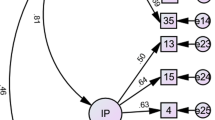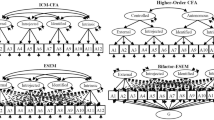Abstract
Current measures of grit misrepresent its original conceptualization. This chapter aims to outline the flaws of extant grit measures, particularly in light of recent updated recommendations for maximizing construct validity during scale development. After reviewing empirical findings regarding grit’s construct validity, structure, and association with success outcomes, recommendations for the future development of grit will be proposed. Grit was developed as a higher-order construct consisting of two facets: perseverance of effort and consistency of interests. However, the higher order construct of “overall grit” is not supported by item response theory, factor analytic, or structural equation modeling approaches. Grit is currently better interpreted as two separate constructs, possibly within a bifactor model in which “overall grit” does not consist of perseverance and consistency. After controlling for conscientiousness, perseverance explains little incremental variance in success outcomes. However, perseverance may be related to, but distinct from, lower-order facets of conscientiousness. Consistency is much less associated with success outcomes, and its predictive utility is unclear.
Grit researchers would benefit from revising grit measures. Positively and negatively worded items should be used to capture both constructs. An overinclusive set of new items should be administered to heterogeneous samples before the scales are refined. Further structural analysis is recommended, and similar factor analytic, item response theory, and structural equation modeling techniques used for the original grit scale should be employed for any revised measure. Meaningful inferences about grit may only be drawn after such revisions, as the first conceptual iteration of grit is psychometrically unsatisfactory.
Access this chapter
Tax calculation will be finalised at checkout
Purchases are for personal use only
Similar content being viewed by others
Notes
- 1.
This item in particular has seemed to confuse some respondents because of its double negative wording in conjunction with additional negative terms in the response scale, e.g. “disagree,” resulting in low factors loadings and general model improvement if excluded or rewritten (Fosnacht et al., 2018; Tyumeneva et al., 2017). It may be prudent to assume this item in particular is inappropriate for samples with less education or a lower reading level than others. Revisions of the grit scale should avoid similar double-negative wording in the interest of ease for all respondents.
References
Clark, L. A., & Watson, D. B. (1995). Constructing validity: Basic issues in objective scale development. Psychological Assessment, 7, 309–319. https://doi.org/10.1037/1040-3590.7.3.309.
Clark, L. A., & Watson, D. (2019). Constructing validity: New developments in creating objective measuring instruments. Psychological Assessment, 31(12), 1412–1427. https://doi.org/10.1037/pas0000626.
Costa, P. T., McCrae, R. R., & Dye, D. A. (1991). Facet scales for agreeableness and conscientiousness: A revision of the NEO personality inventory. Personality and Individual Differences, 12(9), 887–898.
Credé, M. (2018). What shall we do about grit? A critical review of what we know and what we don’t know. Educational Researcher, 47(9), 606–611. https://doi.org/10.3102/0013189X18801322.
Credé, M., & Kuncel, N. R. (2008). Study habits, study skills, and study attitudes: The third pillar supporting collegiate academic performance. Perspectives on Psychological Science, 3, 415–453.
Credé, M., & Harms, P. D. (2015). 25 years of higher order confirmatory factor analysis in the organizational sciences: A critical review and development of reporting recommendations. Journal of Organizational Behavior, 36, 845–872.
Credé, M., Harms, P. D., Niehorster, S., & Gaye-Valentine, A. (2012). An evaluation of the consequences of using short measures of the big five personality traits. Journal of Personality and Social Psychology, 102, 874–888.
Credé, M., Roch, S. G., & Kieszczynka, U. M. (2010). Class attendance in college: A meta-analytic review of the relationship of class attendance with grades and student characteristics. Review of Educational Research, 80, 272–295.
Credé, M., Tynan, M. C., & Harms, P. D. (2017). Much ado about grit: A meta-analytic synthesis of the grit literature. Journal of Personality and Social Psychology, 113(3), 492–511. https://doi.org/10.1037/pspp0000102.
Datu, J. A. D., Valdez, J. P. M., & King, R. B. (2015). Perseverance counts but consistency does not! Validating the short grit scale in a collectivist setting. Current Psychology, 35, 121–130. https://doi.org/10.1007/s12144-015-9374-2.
Datu, J. A. D., Yuen, M., & Chen, G. (2017). Development and validation of the Triarchic model of grit scale (TMGS): Evidence from Filipino undergraduate students. Personality and Individual Differences, 114, 198–205. https://doi.org/10.1016/j.paid.2017.04.012.
Disabato, D. J., Goodman, F. R., & Kashdan, T. B. (2019). Is grit relevant to well-being and strengths? Evidence across the globe for separating perseverance of effort and consistency of interests. Journal of Personality, 87, 194–211.
Duckworth, A. L. (2016). Grit: The power of passion and perseverance. New York: Scribner.
Duckworth, A. L., Peterson, C., Matthews, M. D., & Kelly, D. R. (2007). Grit: Perseverance and passion for long-term goals. Journal of Personality and Social Psychology, 92(6), 1087–1101. https://doi.org/10.1037/0022-3514.92.6.1087.
Duckworth, A. L., & Quinn, P. D. (2009). Development and validation of the short grit scale (grit-S). Journal of Personality Assessment, 91(2), 166–174. https://doi.org/10.1080/00223890802634290.
Dul, J. (2016). Necessary condition analysis (NCA): Logic and methodology of “necessary but not sufficient” causality. Organizational Research Methods, 19(1), 10–52. https://doi.org/10.1177/1094428115584005.
Fosnacht, K., Copridge, K., & Sarraf, S. (2018). How valid is grit in the postsecondary context? A construct and concurrent validity analysis. Research in Higher Education. https://doi.org/10.1007/s11162-018-9524-0.
Goldberg, L. R., Johnson, J. A., Eber, H. W., Hogan, R., Ashton, M. C., Cloninger, C. R., & Gough, H. C. (2006). The international personality item Pool and the future of public-domain personality measures. Journal of Research in Personality, 40, 84–96. https://doi.org/10.1016/j.jrp.2005.08.007.
Gonzalez, O., Canning, J. R., Smyth, H., & Mackinnon, D. (2019). A psychometric evaluation of the short grit scale: A closer look at its factor structure and scale functioning. European Journal of Psychological Assessment., 1–12. https://doi.org/10.1027/1015-5759/a000535.
Guo, J., Tang, X., & Xu, K. M. (2019). Capturing the multiplicative effect of perseverance and passion: Measurement issues of combining two grit facets. Proceedings of the National Academy of Sciences, 116(10), 3938–3940.
Hayton, J. C., Allen, D. G., & Scarpello, V. (2004). Factor retention decisions in exploratory factor analysis: A tutorial on parallel analysis. Organizational Research Methods, 7, 191–205.
KIPP. (2019). Character strengths. Retrieved November 22, 2019, from http://www.kipp.org/approach/character/
Kline, R. B. (2011). Principles and practice of structural equation modeling (3rd ed.). New York: Guilford publications.
Kuncel, N. R., Hezlett, S. A., & Ones, D. S. (2004). Academic performance, career potential, creativity, and job performance: Can one construct predict them all? Journal of Personality and Social Psychology, 86(1), 148–161. https://doi.org/10.1037/0022-3514.86.1.148.
Loevinger, J. (1954). The attenuation paradox in test theory. Psychological Bulletin, 51, 493–504.
Loevinger, J. (1957). Objective tests as instruments of psychological theory. Psychological Reports, 3, 635–694.
Meehl, P. E. (1978). Theoretical risks and tabular asterisks: Sir Karl, Sir Ronald, and the slow progress of soft psychology. Journal of Consulting and Clinical Psychology, 46, 806–834.
Muenks, K., Wigfield, A., Yang, J. S., & O’Neal, C. R. (2017). How true is grit? Assessing its relations to high school and college students’ personality characteristics, self-regulation, engagement, and achievement. Journal of Educational Psychology, 109(5), 599–620.
Pace, V. L., & Brannick, M. T. (2010). How similar are personality scales of the “same” construct? A meta-analytic investigation. Personality and Individual Differences, 49, 669–676.
Poropat, A. E. (2009). A meta-analysis of the five-factor model of personality and academic performance. Psychological Bulletin, 135, 322–338.
Robbins, S. B., Lauver, K., Le, H., Davis, D., Langley, R., & Carlstrom, A. (2004). Do psychosocial and study skill factors predict college outcomes? A meta-analysis. Psychological Bulletin, 130, 261–288.
Roth, B., Becker, N., Romeyke, S., Schäfer, S., Domnick, F., & Spinath, F. M. (2015). Intelligence and school grades: A meta-analysis. Intelligence, 53, 118–137. https://doi.org/10.1016/j.intell.2015.09.002.
Russell, D. W. (2002). In search of underlying dimensions: The use (and abuse) of factor analysis in personality and social psychology bulletin. Personality and Social Psychology Bulletin, 28, 1629–1646.
Schechtman, N., DeBarger, A. H., Dornsife, C., Rosier, S., & Yarnall, L. (2013). Promoting grit, tenacity, and perseverance: Critical factors for success in the 21st century. Washington, DC: U.S. Department of Education, Office of Education Technology. Retrieved from http://pgbovine.net/OET-Draft-Grit-Report-2-17-13.pdf
Schmidt, F. T., Fleckenstein, J., Retelsdorf, J., Eskreis-Winkler, L., & Möller, J. (2019). Measuring grit: A German validation and domain-specific approach to grit. European Journal of Psychological Assessment, 35(3), 436–447.
Schmidt, F. T., Nagy, G., Fleckenstein, J., Möller, J., & Retelsdorf, J. (2018). Same same, but different? Relations between facets of conscientiousness and grit. European Journal of Personality, 32, 705–720.
Schmitt, N., & Stults, D. M. (1985). Factors defined by negatively keyed items: The result of careless respondents? Applied Psychological Measurement, 9, 367–373.
Smith, E. V. (2002). Detecting and evaluating the impact of multidimensionality using item fit statistics and principal component analysis of residuals. Journal of Applied Measurement, 3, 205–231.
Swain, S. D., Weathers, D., & Niedrich, R. W. (2008). Assessing three sources of misresponse to reversed Likert items. Journal of Marketing Research, 45, 116–131.
Tyumeneva, Y., Kardanova, E., & Kuzmina, J. (2017). Grit: Two related but independent constructs instead of one. Evidence from item response theory. European Journal of Psychological Assessment, 35(4), 469–478. https://doi.org/10.1027/1015-5759/a000424.
van de Vijver, F. J. R. (2002). Cross-cultural assessment: Value for money? Applied Psychology: An International Review, 51(4), 545–566. https://doi.org/10.1111/1464-0597.00107.
van Zyl, L. E., Olckers, C., & Roll, L. C. (2020). The psychometric properties of the grit-O scale within the Twente region in the Netherlands: An ICM-CFA vs. ESEM approach. Frontiers in Psychology, 11, 796. https://doi.org/10.3389/fpsyg.2020.00796.
Vazsonyi, A. T., Ksinan, A. J., Jiskrova, G. K., Mikuška, J., Javakhishvili, M., & Cui, G. (2019). To grit or not to grit, that is the question! Journal of Research in Personality, 78, 215–226.
Wirth, R. J., & Edwards, M. C. (2007). Item factor analysis: Current approaches and future directions. Psychological Methods, 12, 58–79.
Author information
Authors and Affiliations
Corresponding author
Editor information
Editors and Affiliations
Rights and permissions
Copyright information
© 2021 The Editor(s) (if applicable) and The Author(s), under exclusive license to Springer Nature Switzerland AG
About this chapter
Cite this chapter
Tynan, M.C. (2021). Deconstructing Grit’s Validity: The Case for Revising Grit Measures and Theory. In: van Zyl, L.E., Olckers, C., van der Vaart, L. (eds) Multidisciplinary Perspectives on Grit. Springer, Cham. https://doi.org/10.1007/978-3-030-57389-8_8
Download citation
DOI: https://doi.org/10.1007/978-3-030-57389-8_8
Published:
Publisher Name: Springer, Cham
Print ISBN: 978-3-030-57388-1
Online ISBN: 978-3-030-57389-8
eBook Packages: Behavioral Science and PsychologyBehavioral Science and Psychology (R0)




